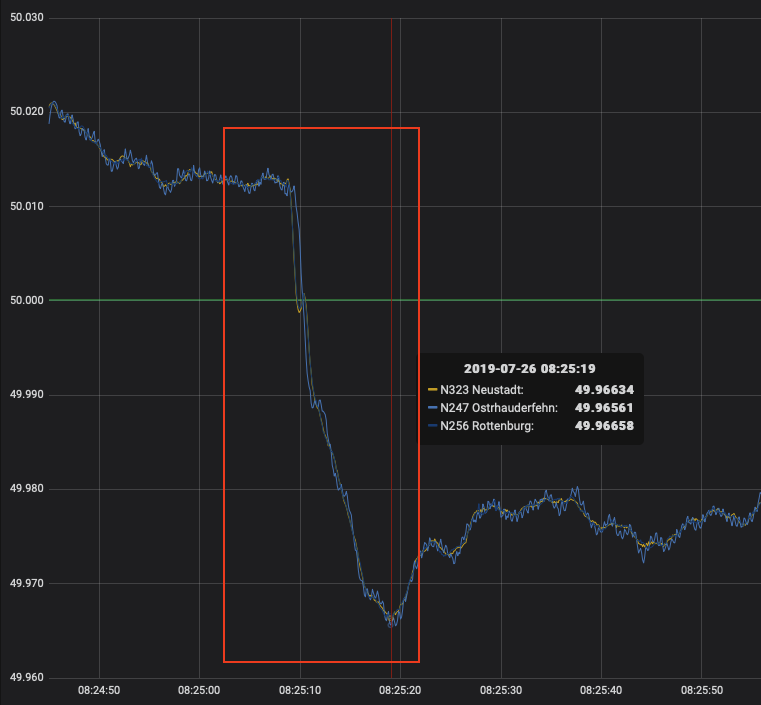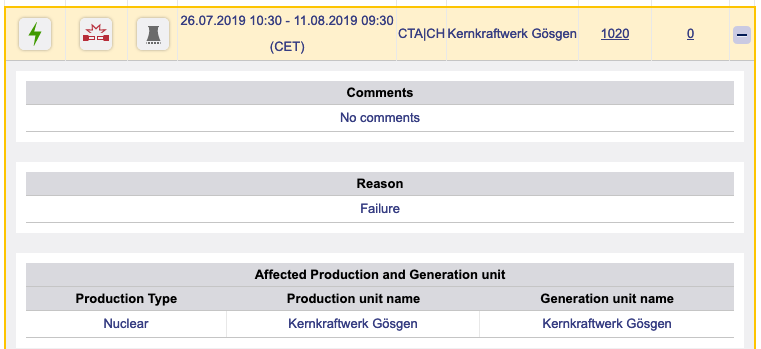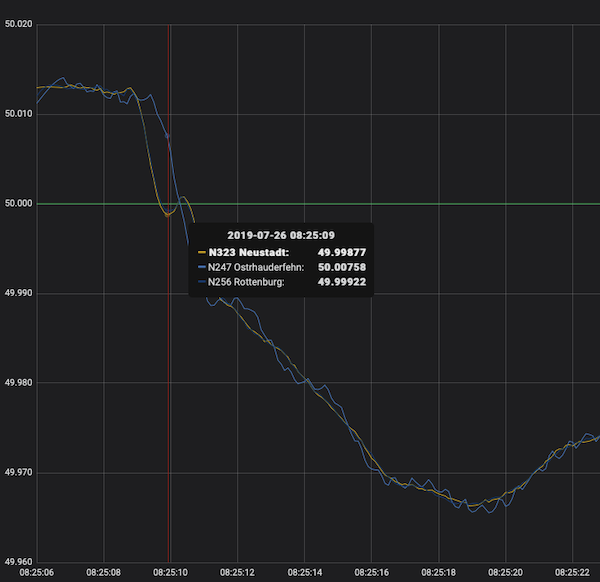Effects of a turbine trip on the frequency of the grid?
On the 26 July 2019 a turbine trip occured at the Gösgen nuclear power plant (CH). According to the operator, Kernkraftwerk Gösgen-Däniken AG, the reason for the TUSA was a short circuit in a switchgear building..
Why would a turbine trip affect the mains frequency at all?
A turbine trip results in a load shedding to zero. This means that the power plant is unexpectedly no longer available to generate electrical energy. As explained in our article on the underfrequency incident in January 2019, generation and consumption of electrical energy must balance each other almost exactly at any one time. The equilibrium of generation and consumption is reflected in the grid frequency. If, as in the case of the above-mentioned turbine trip, there is a sudden undersupply of electrical energy, this is reflected in a very significant drop in the grid frequency with a strong gradient, i.e. a strong change in frequency in a short period of time.

In the case of Gösgen NPP, a power reduction from 1020 MW to 0 MW, i.e. a loss of around 1 GW production that was no longer contributing to the grid and had to be absorbed by primary control reserve.

The figure shows the extract of the TUSA publication in the ENTSO-E database.
The design case for a fault in the UCTE grid may be up to 3000 MW (UCTE Operation Handbook, Policy 1: Load-Frequency Control and Performance, Section A-D3.1.Reference Incident for the UCTE SYNCHRONOUS AREA), i.e. about three times the NPP that was taken off the grid with this TUSA in Gösgen. Since a large number of power plants with high total output were connected to the grid in the morning hours at the time of the outage, there was a negative frequency deviation of approx. 50 mHz. However, this did not bring the grid frequency anywhere near the 49.8 Hz range.
Impact on frequency varies with location
Interesting in the following graph is the frequency curve at the measuring stations shown. It shows that the frequency deviation was visible about one second earlier in Neustadt and Rottenburg than in Ostrhauderfehn, which is much further away. Both Neustadt and Rottenburg are located in the south of Germany and thus much closer to the location of the disturbance than Ostrhauderfehn in the north of Germany. The temporal difference in the frequency deviation is probably due to the distance between the failure location and the frequency recorder site, but also to the fact that networks behave differently locally.

Recovery of the mains frequency
Since the grid frequency had dropped sharply due to the unavailabilty of the NPP caused by the turbine trip, it must be restored to the target frequency range. The primary control reserve has the task of stopping the frequency drop and initially stabilising the mains frequency at the new level. Subsequently, the transmission system operators return the grid frequency to the target range of 50 Hz +/- 10 mHz by using secondary control power.

The event shows that a TUSA of a NPP, but also a reactor emergency shutdown, an RESA, with the associated drop in generator power can be well controlled with high availability of flywheel masses on the grid, but there are still visible frequency effects in the power grid.
Die Wirkung des Frequenzeinbruchs ist sehr ähnlich dem des [Frequenzeinbruchs zum Stundenübergang](The effect of the frequency dip is very similar to that of the frequency dip at hourly transition by trading products. We will take a closer look at similarities, differences and associated network effects in another article.
We will soon show and analyse the effect of local frequency differences or locally occurring patterns in an article here on gridradar.net.
